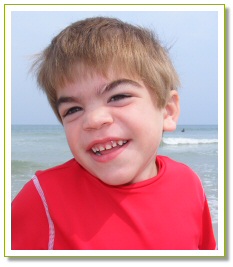
Sanfilippo syndrome is a genetic error of metabolism. It is a mucopolysaccharidoses, an MPS disorder, MPSlll. Mucopolysaccharides are long chains of sugar molecules, which are used in building connective tissues. When the body is finished using these molecules, it breaks them down, with enzymes, and disposes of them. Children with Sanfilippo syndrome are missing or are deficient in the enzyme to break down the molecules. Instead, the body stores these molecules in the cells.This storage causes progressive damage.
There are four different types of Sanfilippo syndrome. Each type is different and named according to which enzyme is missing or defective.
- Sanfilippo Type A is the most common. It is considered the most severe type with earlier death than the others. These children are deficient in the enzyme Heparan N-sulfatase.
- Sanfilippo Type B is the second most common. This is the result of a deficiency in N-acetyl-alpha-D-glucosaminidase.
- Sanfilippo Type C is caused by a deficiency in Acetyl-CoAlpha-glucosaminide acetyltransferase.
- Sanfilippo Type D is caused by a deficiency in N-acetylglucosamine 6-sulfatase.
Sanfilippo syndrome was first described in 1963 by Dr. Sylvester Sanfilippo and is considered rare, with an occurrence of 1 in every 70,000 births. It is an autosomal recessive hereditary disorder, which means, both parents must be carriers in order for the child to be affected. There is a one in four chance of having a child born with Sanfilippo syndrome. There is a two in three chance that unaffected children will be carriers.
Sanfilippo syndrome is a progressive disorder, meaning that at birth the children appear typical and do not show signs of the disorder. As the disease progresses the children degenerate, losing the ability to speak, walk, eat and eventually lose their lives.
In the first stage of the disorder it is noticed that the child lags behind and develops sleep and behavioral issues, most have frequent ear and or throat infections, often times recurrent loose bowels. The child may also have a larger than average head size.
In the second stage, the child may become extremely active, restless, and often have very difficult behavior. Vision becomes a issues with many at this stage as well. Some children have severe sleep disturbances. Many like to chew on their hands and clothing. Language and understanding will gradually become lost. Many lose their swallowing ability and begin eating pureed foods and or move to receiving a feeding tube. There are many documented cases of suspected intracranial pressure as well in Sanfilippo children. This is usually managed by the addition of a drug generically called Diamox ( a diuretic for removing fluid from the brain) or inserting a shunt if the child is young enough to undergo surgery.
In the third stage the child begins to slow down. They have difficulty walking, falling often eventually losing the ability to walk altogether. Movement disorders (dystonia, myoclonus etc. ) and contractures of hands, fingers and other limbs can also occur.
Most children do experience seizures at some point, joint stiffness, upper respiratory infections, hearing loss, dementia, hyperactivity, aggressive behavior, incontinence, bowel issues of both loose and or compacted stools, severe intellectual impairment, partial paralysis, growth retardation and vision impairment.
The current life expectancy is 10-20 years.
The Sanfilippo Children, documentary | 2011 “This is the story of children with the Sanfilippo syndrome, and their families…” A documentary directed by Marie-Fleur Stalder. Voice: Frederic Pollier, Music: Patrick Muller. With the support of the Sanfilippo Foundation and the Swiss Lottery. This video is real life and real families.
To view Team Sanfilippo Foundation Brochure click here.
TSF Inc. is a registered 501(c)3 Tax ID # 46-4027239